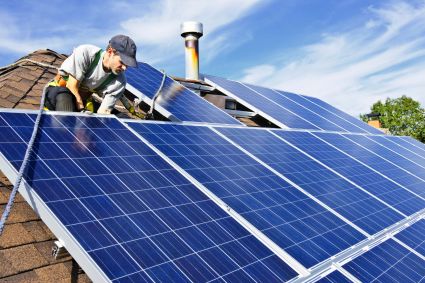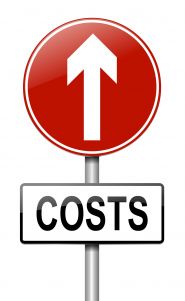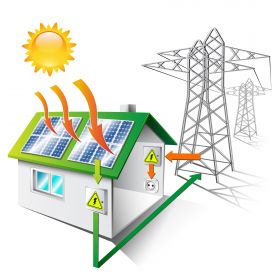Average Cost of Solar Panels New Jersey
What is the average cost of solar panels?
The cost of solar panels has dropped considerably over the last decade. According to the National Renewable Energy Laboratory (NREL), residential solar prices are lowest in more than 30 years. For example, a typical six-kilowatt (kW) residential system could cost as little as $15,000 — or about $2.50 per watt. This is almost half the cost of a similar system in 2008.
The U.S. Department of Energy’s 2014 Sunshot Initiative has set a goal for solar power to be cost-competitive with traditional forms of electricity by 2021. As solar technology advances, prices are expected to continue to fall, opening up new markets and making solar increasingly competitive.
Cost of Solar Panels By Type
The cost of solar panels is different for each type. Each system is different with its prices depending on the size, location, and installation.

Monocrystalline Solar Panels
Monocrystalline solar panels (the most energy-efficient option) range in price from $1 to $1.50 per watt, implying that a 6kW solar panel system (often known as a solar system) will cost between $6,000 and $9,000.
Polycrystalline Solar Panels
While the least energy-efficient option, polycrystalline solar panels are still popular due to their low cost. They average $1 to $1.20 per watt, implying that a 6kW solar panel system will cost between $5,400 and $7,800. This is typically the cheapest option.
Thin Film Solar Panels
The least expensive type of solar panels is thin-film solar panels, which are made from amorphous silicon. They are best for areas that don’t get a lot of sunlight, as they perform better in low light conditions. However, they have a much lower conversion efficiency rate than the other two types. Thin film is the only type currently available with negative costs, meaning that in some cases, homeowners can save money by installing these panels.
Solar Panel cost for home use
The average price for a solar panel system ranges from $16,000 to $35,000. The size of the system varies depending on how much electric energy a homeowner uses a year and location. Installations can cost more in some areas than others. For example, installation costs can run high in cities with lots of tall trees because it takes more time and equipment to set up the system.
Solar panels are one of the easiest renewable energy options to install on your property. They don’t require any fuel for power generation because they rely on sunlight. While solar panels may cost more than other types of energy, numerous solar incentives and rebates can cut the cost significantly if you know where to look.
Solar power is so affordable now that installing solar panels has become as simple as installing a new roof with no mess or fuss. The only upkeep you’ll need to worry about is routine inspections of your electrical equipment like circuit breakers or fuses that may need occasionally adjusting if they experience power fluctuations.
Solar Panel Prices Per Watt

The average cost of solar panels has been coming down significantly, and installation prices have fallen as a result. According to recent estimates, the average solar panel system costs about $3 per watt today. That’s almost half what it was five years ago.
In other words, if you had a 5 kilowatt (5,000 watts) system installed today, it would cost you about $15,000. Five years ago the same system would have run $25,000+
The price of complete solar PV systems has fallen so far that in some areas of the US and around the World Solar PV is now cheaper than retail electricity. If you get your power from your own solar panels, you are saving more money than ever before.
Solar Panel Cost Per Square Foot
A final cost alternative to consider is the per-square-foot cost of your entire system. Consumers considering rooftop panels can expect about 650 square feet or 52 square meters for each kilowatt of power that they plan to produce. That means a typical six-kW residential solar system will cover approximately 32 square meters (a little more than 350 square feet).
And while not a hard and fast rule, you can expect to pay about $1 per watt for every 10 square feet of panels installed. That means the average home installation will cost between $7,000 and $8,500.
Various other factors also affect the final solar installation price—the cost of solar panels, inverters, and wiring equipment. Whether or not you’ve already been equipped for solar power owing to innovative grid technology, the amount of sunshine your area receives, and any state or federal tax incentives you may qualify for are just a few factors to consider.
Average Cost of Solar Panels by State
The cost of installing a solar panel varies significantly from one state to the next. This is due to differences in regional labor and overhead costs and state and local tax incentives for renewable energy.

Arizona
Arizona is the state with the cheapest average solar costs. It has a lot to do with its abundant sunshine, but it’s also because the state requires less red tape for installing rooftop panels. The average cost of a 5-kW solar system in Arizona is $12,450.
Arizona also has a state tax credit of $1 per watt and a higher Renewable Energy Standard requiring 15% of all electricity sold in the state to come from renewable resources by 2025.
California
Solar panels in California cost an average of $11,985 to $16,215 for a complete installation. On a cost per watt ($/W) basis, solar panel installations in California range in cost from $2.40 to $3.24 on average. Since California has relatively high labor costs, this is one reason why the average cost per watt of solar panels in the state is higher than in Arizona.
Colorado
The average solar panel cost in Colorado is $3.09/W. The out-of-pocket expense for a rooftop system in Denver is about $13,132 to $17,768 for a panel system size 5 kilowatts (kW).
Texas
Solar panel prices in Texas start at $2.70 per watt, which is well below the national average. Given a solar panel system size of 5kW, the typical solar installation in Texas costs between $11,475 and $15,525, with an average gross price for solar in Texas of $13,500.
Connecticut
Solar panels in Connecticut start at around $11,390 and top out at around $15,410. State and local residents may be eligible for a rebate and a 26 percent federal tax credit, which can save you money.
Florida
The average solar panel cost in Florida is $2.60 per watt for a solar panel system size of 5 kilowatts (kW)A typical solar installation in the state costs between $11,050 and $14,950, with an average total price of $13,000 for solar energy in Florida.
Georgia
The typical solar panel cost in Georgia is $2.98 per watt. Given a system size of 5 kW, the average solar installation in Georgia costs between $12,665 and $17,135, with the average gross price for solar in the state being $14,900.
New Jersey
The cost of a solar panel system in New Jersey is about $2.76 per watt. Given a solar panel system capacity of 5 kilowatts (kW), the average solar installation in New Jersey costs between $11,730 and $15,870, with an average gross price of $13,800.
New Mexico
Solar panels in New Mexico cost an average of $3.17 per watt, with costs varying considerably based on the size of the system and location. Solar panel systems in New Mexico range in price from $13,472 to $18,228, with the average gross solar installation cost in New Mexico being $15,850.
Factors that contribute to the cost of solar panels
Many factors contribute to the cost of solar panels. The average price of a solar panel has been steadily dropping for years, but there are still several costs you should be aware of before buying a system for your home.
Types of Solar Panel Systems
There are two types of solar panel systems; off-grid and on-grid. An off-grid system doesn’t rely on the electric company to provide power but instead uses batteries. On-grid panels, which aren’t currently available in all states, feed the electricity into the electric company’s power grid.

Off-Grid Solar Panel System
An off-grid solar panel system generates electricity when there is sunlight and stores it in batteries for night or when the sun goes down. This type of system is perfect for someone who lives in an area where utility companies don’t provide service. The power stored in the battery banks allows you to enjoy your appliances without feeling like you’re living under a rock.
On-Grid Solar Panel System
On-grid systems are connected to your home’s wiring and deliver electricity directly to you using the lines from your local utility company. On-grid homes only use their energy when they need extra power or backup if there’s a power outage. If you aren’t planning to buy an electric car, this might be the best option.
Location
Location is another factor that can bring the cost of solar panels down. Solar panel output is directly related to sunlight, so living in hot, sunny climates will yield more power than cooler ones. Areas, where the sun is visible for most of the day, are good candidates for solar panel systems.
System size
The system size is a determining factor in the cost of solar panels. The higher the number of panels, the more expensive it becomes to purchase and install them. System size is evaluated by measuring the amount of energy created annually. Most systems are designed to produce between 3,000 and 6,000 kilowatt-hours (kWh) per year. Also, keep in mind that system size will be limited by your home’s electricity consumption.
Federal Tax Credit
If you installed a solar panel system in 2016, then you may be eligible for an energy tax credit of 26 percent. The Federal Energy Policy Act was created in 2006 and set a goal to provide 100 gigawatts of solar power by 2021. The amount of the tax credits started at 30 percent, but this number has been reducing since its initial inception.
Rebates and incentives
This is an area where you can save some serious money. States, counties, and even cities are offering rebates and incentives to offset the cost of installing solar panels on your property. Some areas also have tax credits that can help bring prices down. You’ll need to investigate what options are available in your area before purchasing because the rules and regulations can change quite frequently.
A trustworthy solar company will provide you with information on what rebates and incentives are available in your area, which can significantly bring down the cost of your system. If you’re considering installing panels yourself, it’s still a good idea to get an estimate from a professional installer who knows what they’re doing.
Expect to see a decrease in solar panel system prices between 3% and 5% every year. The companies offering these panels are reaching out to more and more people, which means that costs will come down even further over time. The only thing you need to do is get a quote from a few companies in your area and then compare them for the best price.
Frequently Asked Questions
How long does it take for solar panels to pay for themselves?
The average time it takes for solar panels to pay for themselves is between 10 and 15 years. That number can be even less if you live in an area with state or local incentives.
What is net metering?
Net metering is a billing mechanism that allows people who generate their power to receive credit for any extra energy they provide to the grid. It also means that if you’re generating more electricity than you need on-site, then you can sell your excess production to your utility company.
How do I apply for incentives in my state or city?
Under federal law, you’re allowed to put solar panels on your roof without having to get permission from anyone. However, you do need to inform yourself about any state or local incentives that will help reduce the cost of getting solar panels installed.
What’s the difference between an on- and off-grid solar system?
Off-grid solar systems are standalone power generators. They provide electricity to the home without being connected to an electric grid, which means they can operate if there’s a blackout or other event that damages the local utility company’s equipment.
On-grid systems are connected to your home’s wiring and deliver electricity directly to you using the lines from your local utility company.
How much electricity can be produced by a home’s solar system?
A solar panel system can typically produce enough power to run your home’s appliances and lighting needs, which would normally use about 6-kilowatt hours per day.
How much can an average person expect to pay for solar panels on their roof?
Solar panel costs are on the decline, which means that some companies offer no-money-down installation. An average 6-kilowatt hour system will cost you about $16,560 but can be even less if incentives are available.
What is the average cost of solar panels for 2,000 sq ft home?
It varies by the amount of energy the system needs to produce, but it’s safe to say that you can expect to pay anywhere from $15,000 and $40,000. when getting solar panels installed on a 2,000-square-foot home.
How much does the average solar system cost?
According to SEIA, the average cost of a residential solar system is about $15,000 to $25,000 range before federal incentives. This would include all costs associated with installation, including permits and grid-connections charges. And it decreases even more after the 26% tax credit.
